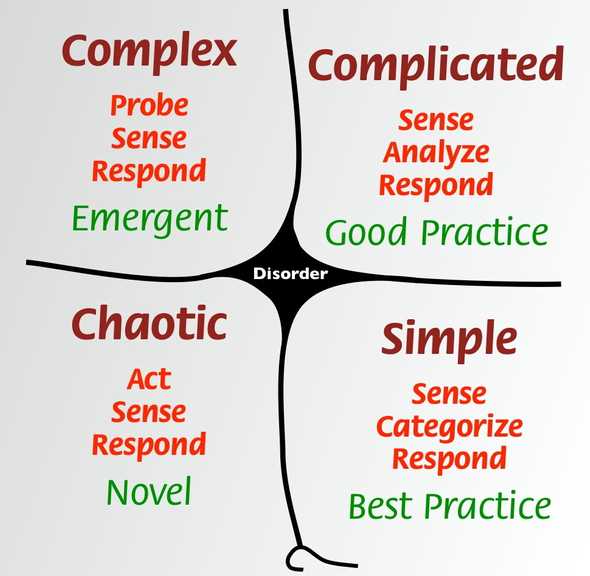Ehren Graber's Blog
Managing Risk and Complexity with the Cynefin Decision making Framework
December 30, 2018
Cynefin: Using the most appropriate problem solving process
Cynefin is a welsh word that loosely translates to “being in a place of many belongings”.
Cynefin is a decision making framework that breaks down a problem into five primary domains: Simple, Complicated, Complex, Chaos, and Disorder. Each of these domains has a specific decision-making approach that helps you make better sense of the situation, and choose the most appropriate way forward.
The Five Domains
Simple Contexts – “The Domain of Best Practice”
Solve problems in the simple domain by sensing, categorizing, and then responding with best practice. A problem in the simple domain is well understood by most Software Engineers. Examples of a simple problem could be dates or contact form submissions.
Complicated Contexts – “The Domain of Experts”
Solve problems in the complicated domain by sensing, analyzing, and then responding with good practice. By planning and consulting with subject matter experts you will find several valid solutions. Examples of a complicated problem are database synchronization and e-commerce platforms.
Complex Contexts – “The Domain of Emergence”
Solve problems in the complex domain by probing, sensing, and then responding to the issue. Often the best way to probe is to create experiments that are safe to fail and gathering data. Through research and analytics “instructive patterns” can emerge. Examples include battlefields, market scale economies, and Apple’s marketing strategy.
Chaotic Contexts – “The Domain of Rapid Response”
Solve problems in the chaotic domain by action, sensing the impact, and responding. Examples of chaotic problems are accidents and emergencies. The key takeaway is to call on experts and continue to act-sense-respond until you emerge from chaos.
Disorder
When you are in disorder you tend to rely on techniques you are the most comfortable with. Most people do not realize when they are in the disorder domain. The key takeaway is to gather more information until you can move to a known domain and act appropriately.
We use Cynefin for organizational strategy, application planning, technical architecture planning and project management because it recognizes the causal differences between systems and allows people to switch management techniques depending on which domain you are in.
Estimating Complexity with Cynefin
Estimating complexity with Cynefin on a scale of 1-5:
- 5 - no one in the world has done it
- 4 - someone has done it but you can’t talk to them and it’s probably your competitor
- 3 - someone else in your company has done it before or you can contact an expert for help
- 2 - someone in your team has done it before
- 1 - everyone on the team has done it before
If you are in disorder and can’t determine what domain you are in then try splitting up the problem into smaller pieces or researching the problem. Don’t estimate in chaos.
The projects with the most value usually have at least one 4 or 5 level of complexity. These are your project differentiators and are what make the project unique. Even if someone else has done a similar project before you don’t know how they did it, what discoveries they made, or what the stakeholders said.
Complexity can even come from losing sight of project’s key differentiator or who the project stakeholders are. This can slow down the team or cause them to solve for the wrong problems.
Written by Ehren Graber who lives and works in Vancouver, Canada building useful things.

